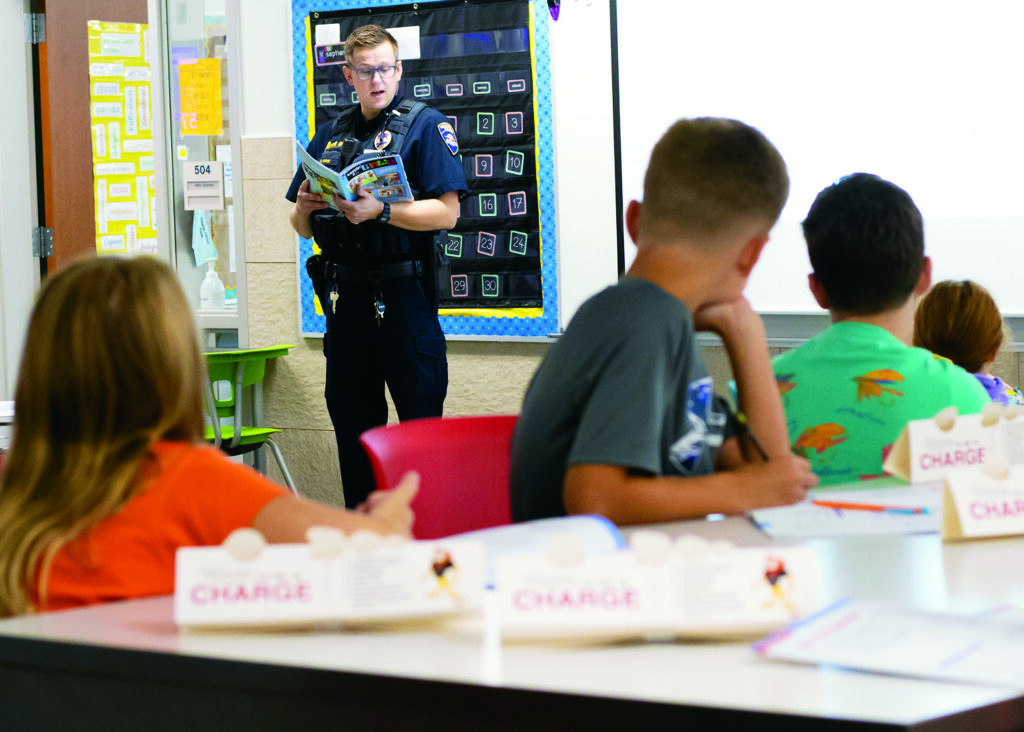
The principle is still the same: Friendly officers from the Moorhead Police Department come to fifth grade classrooms every day to prepare kids to make good decisions.
But if you attended elementary school in the 1980s and 1990s, when the nationwide program was in its infancy, a lot has changed. Your children today are taking a different D.A.R.E. While the much-praised collaboration between the police force and public schools continues unabated, its approach – and much of what School Resource Officer Brandon Heide brings to the classroom this fall – has evolved dramatically.
Gone are the hour-long lectures on illegal drugs meant to warn youngsters away from trying them. Instead, says Heide, the 19 classes he teaches each week at Horizon Middle School focus far more on broader challenges facing preteens. Among them: bullying, peer pressure and tools for good decision-making in every area of their lives. Alcohol and tobacco resistance strategies are included, too.
School Resource Officer Jordan Werk, who was in change of D.A.R.E. education during the 2021-22 school year, says that she went through the old curriculum when growing up in central Minnesota. “It was all about drugs – what they are, what they do and why they can hurt you.” The officer did most of the talking.
Today that practice has been turned on its head. The new D.A.R.E. curriculum, introduced in 2009 and adopted nationally by 2013, emphasizes two-way communication, with the officer posing scenarios and the students chiming in about their own lives and the challenges they have faced or witnessed. “A lot of it is give and take,” Heide reports.
“What I do is fill in the blanks. They see older kids smoking – at least one or two in every class bring up vaping. They’re very aware. They ask, ‘So what do I do? What if it’s offered to me?’ So we talk about resistance strategies they can use in different situations.”
The change in focus from all-drugs to decision-making was driven by research on the effectiveness of D.A.R.E. training. Begun in Los Angeles in 1983, research showed the widely applauded substance-avoidance program didn’t work as intended. According to reporting in Scientific American, “Despite being the nation’s most popular substance-abuse prevention program, D.A.R.E. did not make you less likely to become a drug addict or even to refuse that first beer from your friends.” According to an evaluation in 1994, it showed only a small short-term reduction in tobacco use, and none at all for alcohol and marijuana.
Instead, the nonprofit program sponsor, D.A.R.E. America, turned to an approach that does seem to send boys and girls down a healthier path: “The new course, called ‘keepin’ it REAL,’ differs in both form and content from the former D.A.R.E. — replacing long, drug-fact laden lectures with interactive lessons that present stories meant to help kids make smart decisions.”
Even the meaning of the program’s name was adjusted. Now, says Werk, the D in D.A.R.E. stands for “defining the problem.” A is “assess your options.” R is “respond” – making your choice. The final E is for “evaluation,” when you look back afterwards on how well the choice you made worked out and its consequences.
And this decision-making approach, designed by behavioral scientists rather than cops, does work. Instructors speak only for about eight minutes during each lesson, partly so students can spend more time practicing tough decisions in activities with their friends. “If we teach good decision-making skills, it should transfer from one high-risk behavior to the next,” Heide says.
Heide is in his third year with the Moorhead police; Werk has been an officer for six and one-half years. Both were excited about the opportunity to work in the schools.
They prepared for their role in the classrooms at an intense two-week D.A.R.E. school. “They teach you to be a teacher, rather than a police officer,” Heide explains. “Most cops have never been in front of a classroom of kids.” Asked about what surprised him, he says, “The most shocking thing? How tiring it is!”
Both officers say the best part of their assignment as school resource officers is the kids. “I like to hang out with them. A big part of our job is building good relationships … letting them know that talking to a police officer isn’t scary.” Much of those trusting relationships is based on informal interaction. “I’ve played basketball after lunch and tossed and catch a football while they’re waiting for the bus,” he says.
Many children, he says, believe cops to be stern, intimidating people to be afraid of. Tearing down that wall is one of their central goals. “If we can build trusting relationships when they’re in fifth grade and even years after, they’ll be more willing to talk to us,” Werk says.
“That’s the best part of the job: I get to hang out with kids on their good days. In law enforcement, we usually see people on the worst days of their lives.
And though Heide is only in his first month of D.A.R.E. classes at Horizon West, he has already seen perks from that growing bond.
“When I was driving a [police] car in the Greater Moorhead Days parade, kids yelled, ‘Hey, that’s my D.A.R.E. officer’ and waved,” he reports. “They made me feel a little bit like a celebrity.”


